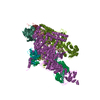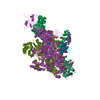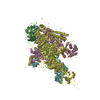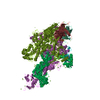[English] 日本語
 Yorodumi
Yorodumi- EMDB-2241: Negative stain reconstruction of PG9 Fab in complex with HIV-1 SO... -
+ Open data
Open data
- Basic information
Basic information
| Entry | Database: EMDB / ID: EMD-2241 | |||||||||
|---|---|---|---|---|---|---|---|---|---|---|
| Title | Negative stain reconstruction of PG9 Fab in complex with HIV-1 SOSIP gp140 trimer | |||||||||
 Map data Map data | Reconstruction of SOSIP gp140 trimer in complex with PG9 Fab | |||||||||
 Sample Sample |
| |||||||||
 Keywords Keywords |  Human Immunodeficiency Virus / Human Immunodeficiency Virus /  HIV / HIV /  Broadly neutralizing antibody / PG9 / Env Broadly neutralizing antibody / PG9 / Env | |||||||||
| Function / homology |  Function and homology information Function and homology informationpositive regulation of plasma membrane raft polarization / positive regulation of receptor clustering / positive regulation of establishment of T cell polarity / virus-mediated perturbation of host defense response / host cell endosome membrane / clathrin-dependent endocytosis of virus by host cell /  viral protein processing / fusion of virus membrane with host plasma membrane / fusion of virus membrane with host endosome membrane / viral protein processing / fusion of virus membrane with host plasma membrane / fusion of virus membrane with host endosome membrane /  viral envelope ...positive regulation of plasma membrane raft polarization / positive regulation of receptor clustering / positive regulation of establishment of T cell polarity / virus-mediated perturbation of host defense response / host cell endosome membrane / clathrin-dependent endocytosis of virus by host cell / viral envelope ...positive regulation of plasma membrane raft polarization / positive regulation of receptor clustering / positive regulation of establishment of T cell polarity / virus-mediated perturbation of host defense response / host cell endosome membrane / clathrin-dependent endocytosis of virus by host cell /  viral protein processing / fusion of virus membrane with host plasma membrane / fusion of virus membrane with host endosome membrane / viral protein processing / fusion of virus membrane with host plasma membrane / fusion of virus membrane with host endosome membrane /  viral envelope / structural molecule activity / virion attachment to host cell / host cell plasma membrane / virion membrane / identical protein binding / viral envelope / structural molecule activity / virion attachment to host cell / host cell plasma membrane / virion membrane / identical protein binding /  plasma membrane plasma membraneSimilarity search - Function | |||||||||
| Biological species |   Homo sapiens (human) / Homo sapiens (human) /    Human immunodeficiency virus 1 Human immunodeficiency virus 1 | |||||||||
| Method |  single particle reconstruction / single particle reconstruction /  negative staining / Resolution: 18.1 Å negative staining / Resolution: 18.1 Å | |||||||||
 Authors Authors | Lee JH / Julien JP / Cupo A / Moore JP / Wilson IA / Ward AB | |||||||||
 Citation Citation |  Journal: Proc Natl Acad Sci U S A / Year: 2013 Journal: Proc Natl Acad Sci U S A / Year: 2013Title: Asymmetric recognition of the HIV-1 trimer by broadly neutralizing antibody PG9. Authors: Jean-Philippe Julien / Jeong Hyun Lee / Albert Cupo / Charles D Murin / Ronald Derking / Simon Hoffenberg / Michael J Caulfield / C Richter King / Andre J Marozsan / Per Johan Klasse / ...Authors: Jean-Philippe Julien / Jeong Hyun Lee / Albert Cupo / Charles D Murin / Ronald Derking / Simon Hoffenberg / Michael J Caulfield / C Richter King / Andre J Marozsan / Per Johan Klasse / Rogier W Sanders / John P Moore / Ian A Wilson / Andrew B Ward /  Abstract: PG9 is the founder member of an expanding family of glycan-dependent human antibodies that preferentially bind the HIV (HIV-1) envelope (Env) glycoprotein (gp) trimer and broadly neutralize the virus. ...PG9 is the founder member of an expanding family of glycan-dependent human antibodies that preferentially bind the HIV (HIV-1) envelope (Env) glycoprotein (gp) trimer and broadly neutralize the virus. Here, we show that a soluble SOSIP.664 gp140 trimer constructed from the Clade A BG505 sequence binds PG9 with high affinity (∼11 nM), enabling structural and biophysical characterizations of the PG9:Env trimer complex. The BG505 SOSIP.664 gp140 trimer is remarkably stable as assessed by electron microscopy (EM) and differential scanning calorimetry. EM, small angle X-ray scattering, size exclusion chromatography with inline multiangle light scattering and isothermal titration calorimetry all indicate that only a single PG9 fragment antigen-binding (Fab) binds to the Env trimer. An ∼18 Å EM reconstruction demonstrates that PG9 recognizes the trimer asymmetrically at its apex via contact with two of the three gp120 protomers, possibly contributing to its reported preference for a quaternary epitope. Molecular modeling and isothermal titration calorimetry binding experiments with an engineered PG9 mutant suggest that, in addition to the N156 and N160 glycan interactions observed in crystal structures of PG9 with a scaffolded V1/V2 domain, PG9 makes secondary interactions with an N160 glycan from an adjacent gp120 protomer in the antibody-trimer complex. Together, these structural and biophysical findings should facilitate the design of HIV-1 immunogens that possess all elements of the quaternary PG9 epitope required to induce broadly neutralizing antibodies against this region. | |||||||||
| History |
|
- Structure visualization
Structure visualization
| Movie |
 Movie viewer Movie viewer |
|---|---|
| Structure viewer | EM map:  SurfView SurfView Molmil Molmil Jmol/JSmol Jmol/JSmol |
| Supplemental images |
- Downloads & links
Downloads & links
-EMDB archive
| Map data |  emd_2241.map.gz emd_2241.map.gz | 10.8 MB |  EMDB map data format EMDB map data format | |
|---|---|---|---|---|
| Header (meta data) |  emd-2241-v30.xml emd-2241-v30.xml emd-2241.xml emd-2241.xml | 11.4 KB 11.4 KB | Display Display |  EMDB header EMDB header |
| Images |  emd_2241.png emd_2241.png | 608.4 KB | ||
| Archive directory |  http://ftp.pdbj.org/pub/emdb/structures/EMD-2241 http://ftp.pdbj.org/pub/emdb/structures/EMD-2241 ftp://ftp.pdbj.org/pub/emdb/structures/EMD-2241 ftp://ftp.pdbj.org/pub/emdb/structures/EMD-2241 | HTTPS FTP |
-Related structure data
| Similar structure data |
|---|
- Links
Links
| EMDB pages |  EMDB (EBI/PDBe) / EMDB (EBI/PDBe) /  EMDataResource EMDataResource |
|---|---|
| Related items in Molecule of the Month |
- Map
Map
| File |  Download / File: emd_2241.map.gz / Format: CCP4 / Size: 15.3 MB / Type: IMAGE STORED AS FLOATING POINT NUMBER (4 BYTES) Download / File: emd_2241.map.gz / Format: CCP4 / Size: 15.3 MB / Type: IMAGE STORED AS FLOATING POINT NUMBER (4 BYTES) | ||||||||||||||||||||||||||||||||||||||||||||||||||||||||||||||||||||
|---|---|---|---|---|---|---|---|---|---|---|---|---|---|---|---|---|---|---|---|---|---|---|---|---|---|---|---|---|---|---|---|---|---|---|---|---|---|---|---|---|---|---|---|---|---|---|---|---|---|---|---|---|---|---|---|---|---|---|---|---|---|---|---|---|---|---|---|---|---|
| Annotation | Reconstruction of SOSIP gp140 trimer in complex with PG9 Fab | ||||||||||||||||||||||||||||||||||||||||||||||||||||||||||||||||||||
| Voxel size | X=Y=Z: 2.18 Å | ||||||||||||||||||||||||||||||||||||||||||||||||||||||||||||||||||||
| Density |
| ||||||||||||||||||||||||||||||||||||||||||||||||||||||||||||||||||||
| Symmetry | Space group: 1 | ||||||||||||||||||||||||||||||||||||||||||||||||||||||||||||||||||||
| Details | EMDB XML:
CCP4 map header:
| ||||||||||||||||||||||||||||||||||||||||||||||||||||||||||||||||||||
-Supplemental data
- Sample components
Sample components
-Entire : Fab fragment of broadly neutralizing antibody PG9 bound to BG505 ...
| Entire | Name: Fab fragment of broadly neutralizing antibody PG9 bound to BG505 SOSIP gp140 HIV-1 trimer |
|---|---|
| Components |
|
-Supramolecule #1000: Fab fragment of broadly neutralizing antibody PG9 bound to BG505 ...
| Supramolecule | Name: Fab fragment of broadly neutralizing antibody PG9 bound to BG505 SOSIP gp140 HIV-1 trimer type: sample / ID: 1000 / Oligomeric state: One Fab binds one SOSIP trimer / Number unique components: 2 |
|---|---|
| Molecular weight | Experimental: 387 KDa / Theoretical: 392 KDa Method: Size exclusion chromatography with in-line multi-angle light scattering (SEC-MALS) |
-Macromolecule #1: Broadly Neutralizing Antibody PG9
| Macromolecule | Name: Broadly Neutralizing Antibody PG9 / type: protein_or_peptide / ID: 1 / Name.synonym: bnAb PG9 Details: Recombinantly expressed antibody Fab fragment. Co-transfected with gene encoding tyroslprotein sulfotransferase 1 (TPST1) Number of copies: 1 / Oligomeric state: monomer / Recombinant expression: Yes |
|---|---|
| Source (natural) | Organism:   Homo sapiens (human) / synonym: Human / Cell: B-Cell Homo sapiens (human) / synonym: Human / Cell: B-Cell |
| Molecular weight | Experimental: 50 KDa / Theoretical: 50 KDa |
| Recombinant expression | Organism:   HEK293T (human) HEK293T (human) |
-Macromolecule #2: HIV-1 SOSIP.664
| Macromolecule | Name: HIV-1 SOSIP.664 / type: protein_or_peptide / ID: 2 / Name.synonym: gp140 / Details: Cotransfected with pcDNA3.1 Furin. / Number of copies: 3 / Oligomeric state: trimer / Recombinant expression: Yes |
|---|---|
| Source (natural) | Organism:    Human immunodeficiency virus 1 / Strain: BG505 / synonym: HIV-1 Human immunodeficiency virus 1 / Strain: BG505 / synonym: HIV-1 |
| Molecular weight | Experimental: 120 KDa / Theoretical: 140 KDa |
| Recombinant expression | Organism: HEK293S GnTI -/- / Recombinant plasmid: pP14 |
-Experimental details
-Structure determination
| Method |  negative staining negative staining |
|---|---|
 Processing Processing |  single particle reconstruction single particle reconstruction |
| Aggregation state | particle |
- Sample preparation
Sample preparation
| Concentration | 0.03 mg/mL |
|---|---|
| Buffer | pH: 7.4 / Details: 50 mM Tris-HCl, 150 mM NaCl |
| Staining | Type: NEGATIVE / Details: 30 sec Nano-W |
| Grid | Details: 400 Cu mesh grid with carbon support, glow discharged at 20 mA for 30 seconds |
| Vitrification | Cryogen name: NONE / Instrument: OTHER |
- Electron microscopy
Electron microscopy
| Microscope | FEI TECNAI F20 |
|---|---|
| Electron beam | Acceleration voltage: 120 kV / Electron source:  FIELD EMISSION GUN FIELD EMISSION GUN |
| Electron optics | Illumination mode: FLOOD BEAM / Imaging mode: BRIGHT FIELD Bright-field microscopy / Nominal defocus max: 0.9 µm / Nominal defocus min: 0.5 µm / Nominal magnification: 100000 Bright-field microscopy / Nominal defocus max: 0.9 µm / Nominal defocus min: 0.5 µm / Nominal magnification: 100000 |
| Sample stage | Specimen holder model: SIDE ENTRY, EUCENTRIC / Tilt angle max: 55 |
| Temperature | Min: 293 K / Max: 293 K |
| Alignment procedure | Legacy - Astigmatism: Objective astigmatism corrected at 100,000x |
| Details | Images taken from 0 to -55 degrees in 5 degree tilt increments. |
| Date | Jul 31, 2012 |
| Image recording | Category: CCD / Film or detector model: GENERIC GATAN (4k x 4k) / Digitization - Sampling interval: 0.109 µm / Number real images: 1283 / Average electron dose: 30 e/Å2 / Details: Images recorded on CCD / Bits/pixel: 16 |
| Tilt angle min | 0 |
| Experimental equipment |  Model: Tecnai F20 / Image courtesy: FEI Company |
- Image processing
Image processing
| CTF correction | Details: Not corrected |
|---|---|
| Final reconstruction | Applied symmetry - Point group: C1 (asymmetric) / Resolution.type: BY AUTHOR / Resolution: 18.1 Å / Resolution method: FSC 0.5 CUT-OFF / Software - Name: Xmipp, EMAN / Number images used: 33431 |
| Details | Particles were picked using DogPicker then processed with Xmipp and EMAN |
 Movie
Movie Controller
Controller














